‘Rocked’: NASA scientists brave bumpy flights into winter storms
A BIOS Treasure: The Tudor Hill Marine Atmospheric Observatory
by: Bermuda Institute of Ocean Sciences
TEMPO Air Pollution Sensor Integrated with Satellite Host
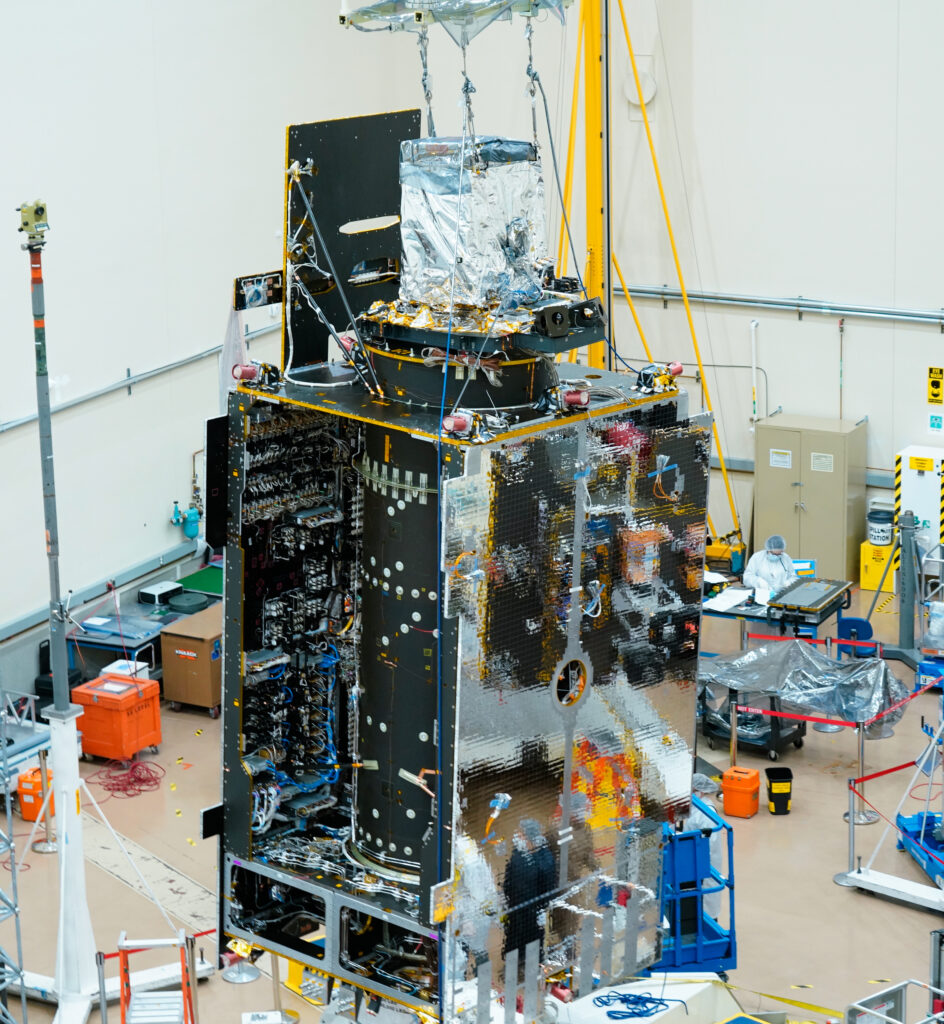
Credits: Image courtesy of Maxar
An air quality sensor that will dramatically improve the way scientists measure air pollution over North America has been joined with its satellite host.
NASA’s Tropospheric Emissions: Monitoring of Pollution (TEMPO) instrument was integrated with Intelsat 40e by Maxar’s Space Program Delivery team in Palo Alto, California. From its geostationary orbit — a high Earth orbit that allows satellites to match Earth’s rotation — TEMPO will take hourly daytime observations of air quality over an area that extends from Puerto Rico to northern Canada, from the Atlantic to the Pacific, encompassing the entire continental United States.
“Because of the hard work and dedication of the entire TEMPO team including our Maxar, Intelsat, and Ball Aerospace partners, we are excited to have completed this significant step toward launching with the IS40e spacecraft ” said Kevin Daugherty, TEMPO project manager at NASA’s Langley Research Center in Hampton, Virginia. “We are looking forward to completing the instrument integration and spacecraft testing in the coming months bringing us closer to delivery of TEMPO’s critical air quality science.”
Air pollution — including ozone, nitrogen dioxide and formaldehyde, and tiny atmospheric particles called aerosols — can have serious consequences for human health and the environment.
Currently scheduled to launch in 2022, TEMPO will also form part of an air quality satellite “virtual constellation” that will offer a more holistic view of how pollution is transported around the Northern Hemisphere. Ball Aerospace in Broomfield, Colorado built the TEMPO instrument.
Kelly Chance, of the Smithsonian Astrophysical Observatory in Cambridge, Massachusetts, is the principal investigator for TEMPO.
NASA Langley Research Center Last Updated: Dec 1, 2021 Editor: Joe Atkinson
https://www.nasa.gov/feature/langley/tempo-air-pollution-sensor-integrated-with-satellite-host
Preparing for Landing: NASA’s S-MODE Wraps up Last Week of Experiments
By Dragana Perkovic-Martin, Principal Investigator for DopplerScatt at NASA’s Jet Propulsion Laboratory // SOUTHERN CALIFORNIA //
11/02/21
Yesterday was a hard down day for the team – everyone needed a rest after a very active week before. The hard down days are in NASA airborne rules and ensure that fatigue does not set in and keep everyone’s safety the top priority.
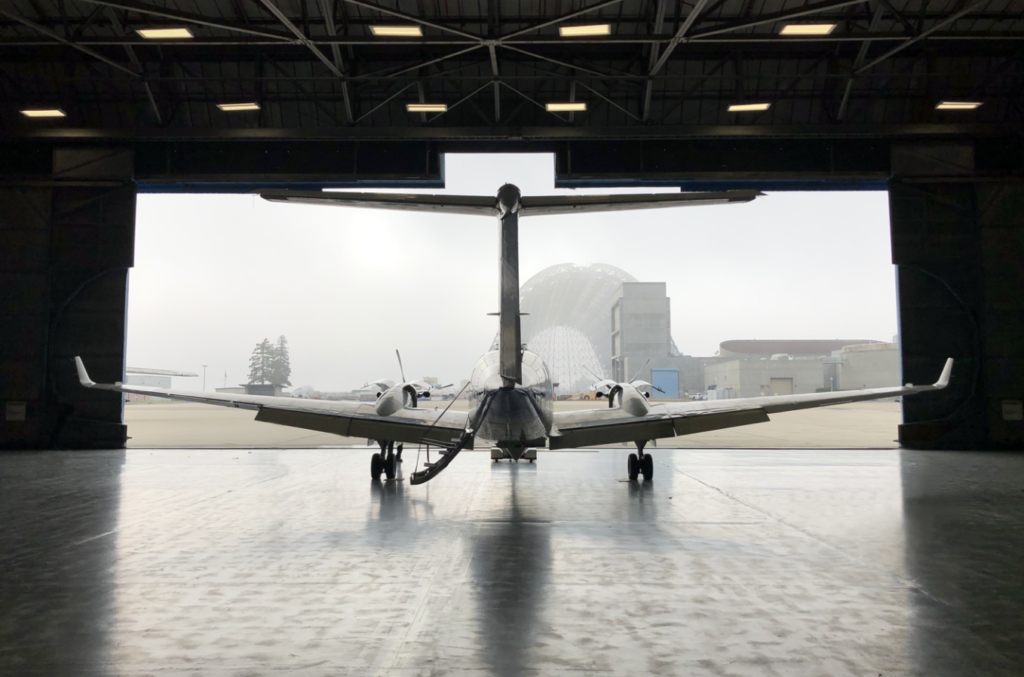
Spooky! NASA King Air B200 and the early morning fog at NASA Ames Research Center. Photo credit: Alex Wineteer / NASA JPL
To fly or not to fly … Today is supposed to be a good day for optical measurements but the pesky fog is really not willing to leave the area of S-MODE operations. We sit and wait for updates from the ship, satellite imagery and forecasts. In the meantime, we are using the Saildrone measurements of wind speed in the area of interest to determine if it’s worthwhile to operate DopplerScatt. The winds are very low. The hourly reports are telling us that the winds have been below DopplerScatt’s threshold for the whole morning, reporting wind speeds of one meter per second. At this wind speed the ocean surface is very still, so still that it may look like a mirror. This is bad news for radar signals bouncing off the surface as their strength depends on the surface roughness. No dice for DopplerScatt today, and the same decision was made for the MOSES and MASS instruments on the Twin Otter.
11/03/21
Remember that pesky problem with the monitor from last week? I overnighted a replacement monitor for the DopplerScatt team since yesterday was a doozy with no flights, they decided to swap out the monitor and keyboard on the plane. Trouble is they did not test that it worked. We just thought, “well what could go wrong, it’s the same model.” What do you know, it did go wrong! I’ll spare you the details and the frantic messaging between myself and the operators, but after some time they realized that the power cable was not plugged in and the monitor was not getting power. All in a day of DopplerScatt deployments!

Crew of the day from left to right: Karthik Srinivasan (JPL DopplerScatt operator), Hernan Posada (AFRC pilot), Jeroen Molemaker (UCLA MOSES operator), James Less (AFRC pilot). Photo credit: Alex Wineteer / NASA JPL
11/04/21
Today is a science extravaganza! We have a big day ahead of us with two NASA King Air B200 flights planned and all of the in-water assets sampling data throughout the day. The weather is finally cooperating and we have a clear yet windy day ahead of us. The plan today is to fly a morning flight – which just took off at 8am – and then another one leaving approximately 6 hours later and flying the exact same pattern. The comparison of data between the two will tell us about the daily variability of the ocean processes.
“This is one of the reasons why I am so excited about S-MODE,” said Hector Torres, DopplerScatt team member, operator and one of the main people responsible for simulating ocean processes. “The results based on theory and numerical simulations produced in the last five years are about to get confirmed or debunked today. Either way it will be a breakthrough!”
Flight one is now done! There were some pesky low clouds right in the area of collection that prevented MOSES from collecting quality data for half of the flight, but the second half was great. DopplerScatt data collection went as planned and data are churning already! We are seeing the first quick look data products trickle in as we watch the afternoon flight take off.
While the first flight was a bit difficult for our optical colleague running the MOSES system, Jeroen Molemaker from the University of California, Los Angeles, the afternoon was gloriously clear and provided a great opportunity for all airborne instruments to collect data at the same time.

Quick look composite image of the sea surface temperature as observed by the MOSES instrument on the November 4, 2021 afternoon flight. The tracks are overlaid on DopplerScatt derived surface current velocities from the morning flight, showing the spatial relationship between currents and density fields. The color scale blue to red has a range of 2°C. Credit: NASA’s S-MODE team / Jeroen Molemaker
Today the S-MODE pilot experiment operated as we envisioned many months ago, with all platforms sampling data throughout the day over the area of interest. The field experiment crew is tired but happy and the team is excited about the science that we will extract from this data set.
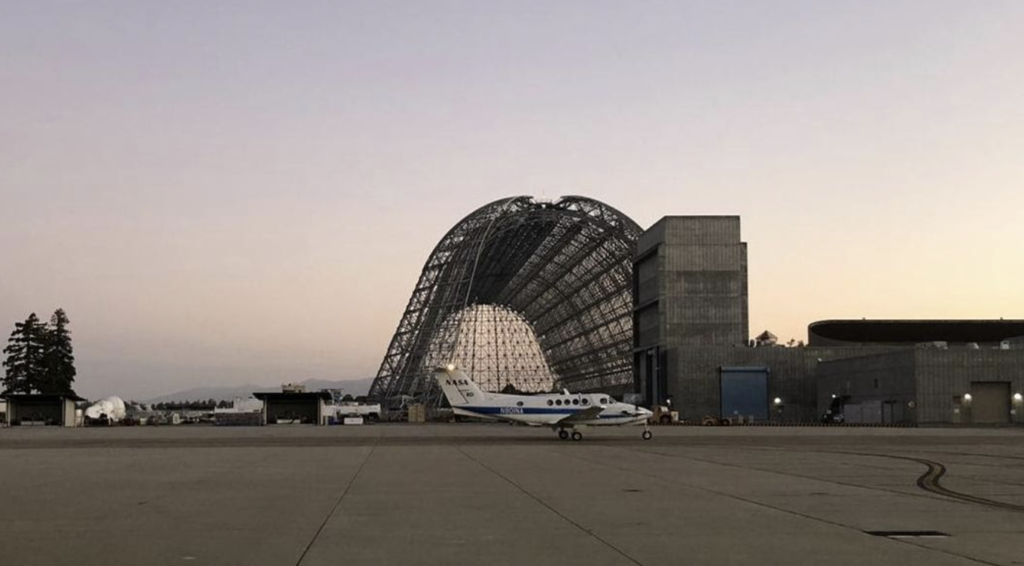
Goodnight moon. NASA King Air B200 on arrival at Moffett Field, California after a long day of flights. Photo credit: Alex Wineteer / NASA Jet Propulsion Laboratory
11/05/21
Today is the final day of the S-MODE pilot campaign. It’s a bittersweet feeling for me as it was so much fun to collaborate and coordinate daily activities with so many people. I will miss that, but I certainly will not miss the hectic calls of “we have a problem with …”
The NASA King Air B200 will fly in the afternoon collecting data in the western region of the S-MODE study area together with the Twin Otter aircraft. Meanwhile, our friends on the ship will start recovering the autonomous assets and make their way toward Newport, Oregon.
Trouble struck again as our GPS unit could not get itself aligned and produce a good navigation solution, requiring a power reset and making S-turns i.e. banking the aircraft left and right in succession. After this excitement things went smoothly for the rest of the flight. You never know what will go wrong during a field deployment, you just know that something will and you need to be prepared to react and fix things without letting the panic set in! Thankfully that is what happened today thanks to Alex Winteer, a DopplerScatt operator from NASA JPL. He performed a cool and collected power reset while in air!
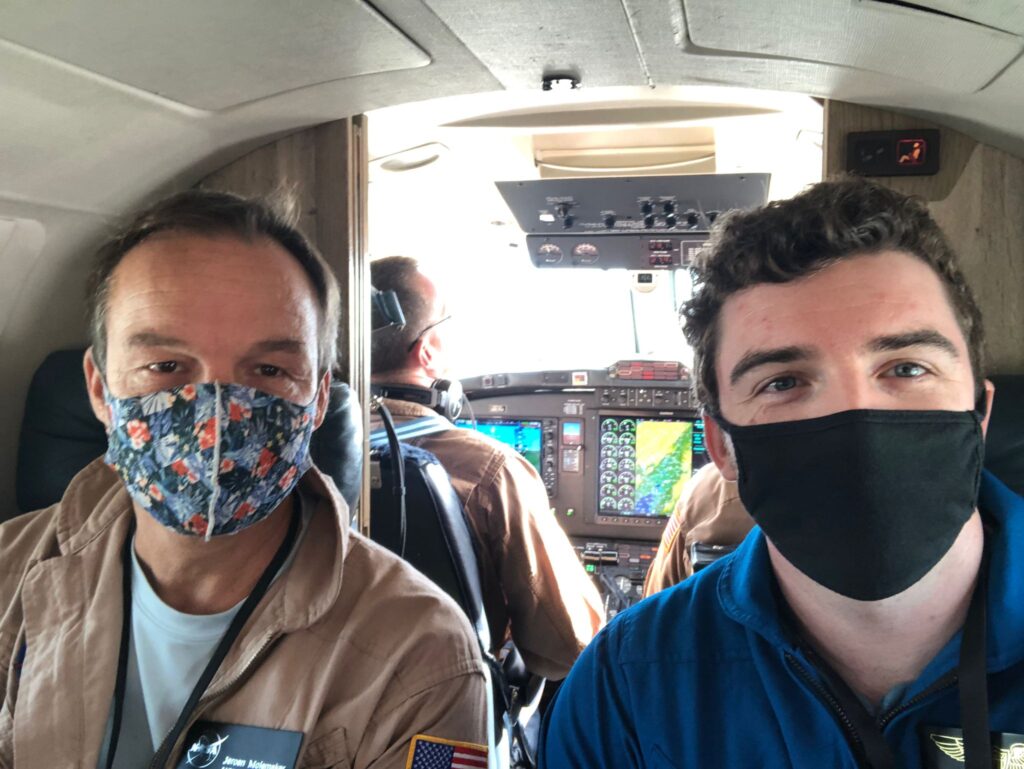
Happy crew on their last flight of the S-MODE pilot campaign. On the left is Jeroen Molemaker (UCLA MOSES operator) and on the right is Alex Wineteer (JPL DopplerScatt operator). Photo credit: Karthik Srinivasan / NASA JPL
Now it is time to work on our post-deployment to do list and eagerly await results of data processing.
I will leave you with two short blurbs from DopplerScatt team members Alex and Karthik about their impressions of the pilot campaign.
“On most days, you don’t wake up looking forward to a boring day. As an instrument operator, a boring day during a deployment, however, is a different story. You look forward to sitting in a small round aluminum tube for 4.5 hours with nothing to do. That is a perfect day – a day when the radar just works. No last minute excitement of monitors not turning on (because someone unplugged it and forgot to plug it back in!) or the satellite phone connection not working. While the entire science team is excited about an action-packed day of coincident data collection, all the instrument operators look forward to is a day where everything just works as it should! Of course, sitting in an aluminum tube for many hours, staring out at the ocean with nothing to do makes you yearn for some excitement, but that is a fleeting thought until you get a text message via satellite link asking you to pay attention to the speed of the aircraft!”
– Karthik Srinivasan, NASA JPL DopplerScatt operator
“I’ve been on quite a few field deployments with DopplerScatt, but none quite as exciting – or as important—as this one. Indeed, such a coordinated effort consisting of multiple aircraft and many assets in the water has never been attempted, and the resulting science will lead to new understanding of our ocean, atmosphere and the climate system as a whole. On Thursday, we attempted two flights for the first time. I operated the first flight: crew brief at 6:30 AM with a takeoff time of 8 AM. Thankfully, our instrument operated normally, and we were able to fly a bit lower –under the clouds – to ensure MOSES could see the ocean surface with its infrared camera. We landed five hours later, at around 1 PM, and I immediately took our data back to our field processing center in the aircraft hangar to start crunching. In the meantime, Karthik took off for our second flight of the day. By the time I finished the first round of processing, it was 5 PM and Karthik was almost back from the second flight, so I went downstairs to welcome him back (and grab the data!). A few hours later, we had both flights processed to quick look data products and I was exhausted. Being just one person, a small part of a much larger mission, it can be easy to lose sight of why we do this, especially when the hours are long. But when the data started pouring in, my exhaustion was quickly replaced by excitement. We were seeing a dataset no one had ever seen before. With these two flights, we are able to not just see the sub-mesoscale structure of the ocean surface over a large area, but we could also see its evolution over time and how the atmosphere interacts with that evolution! There is much work to go in analyzing these data, especially in comparing the many other instruments to our DopplerScatt measurements, but I am grateful to play a part in that analysis, discovery and understanding.”
– Alex Wineteer, NASA JPL DopplerScatt operator
NASA Selects New Mission to Study Storms, Impacts on Climate Models
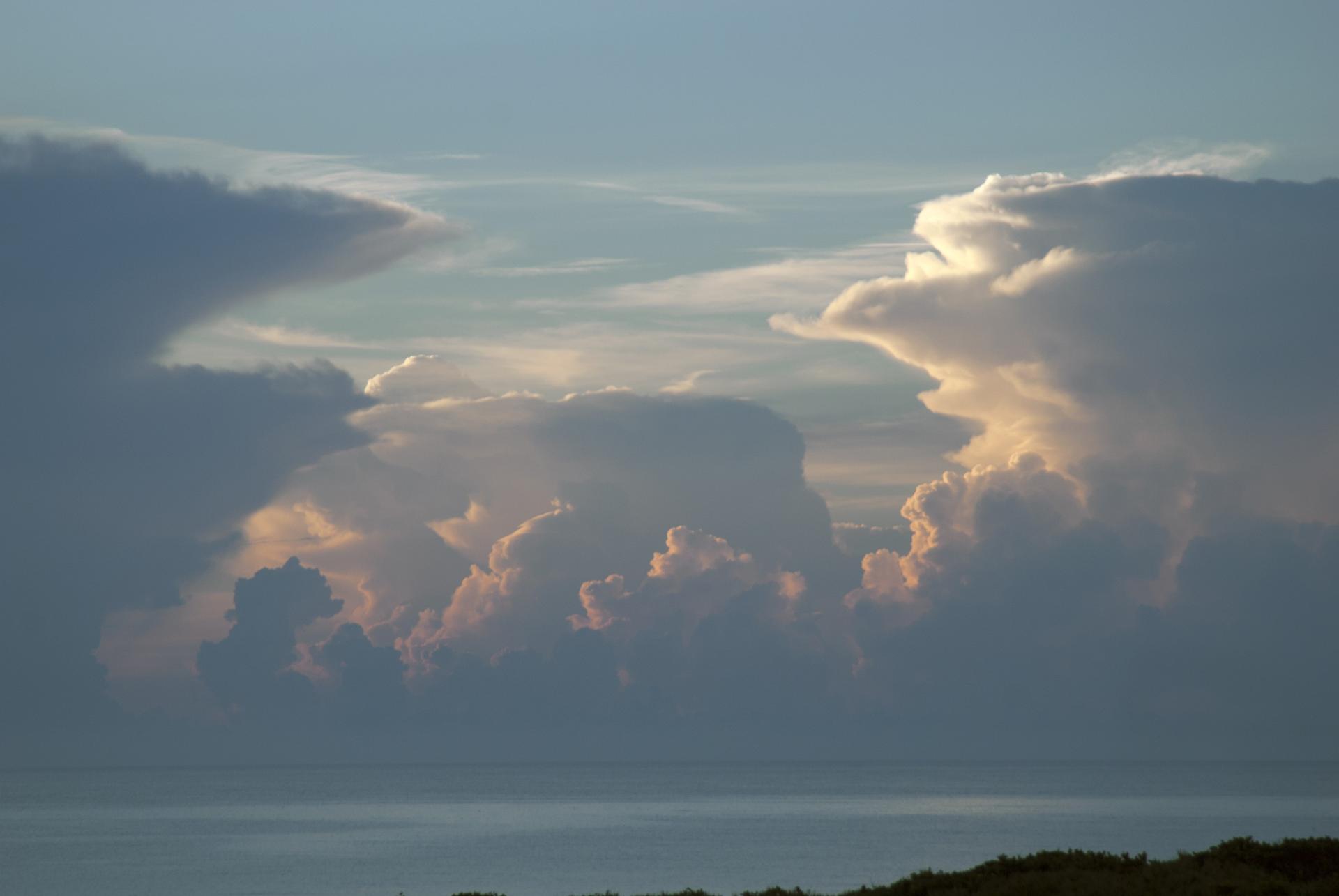
NASA has selected a new Earth science mission that will study the behavior of tropical storms and thunderstorms, including their impacts on weather and climate models. The mission will be a collection of three SmallSats, flying in tight coordination, called Investigation of Convective Updrafts (INCUS), and is expected to launch in 2027 as part of NASA’s Earth Venture Program.
NASA selected INCUS through the agency’s Earth Venture Mission-3 (EVM-3) solicitation that sought complete, space-based investigations to address important science questions and produce data of societal relevance within the Earth science field. NASA received 12 proposals for EVM-3 missions in March 2021. After detailed review by panels of scientists and engineers, the agency selected INCUS to continue into development.
“Every one of our Earth science missions is carefully chosen to add to a robust portfolio of research about the planet we live on,” said Thomas Zurbuchen, associate administrator for the agency’s Science Mission Directorate in Washington. “INCUS fills an important niche to help us understand extreme weather and its impact on climate models – all of which serves to provide crucial information needed to mitigate weather and climate effects on our communities.”
INCUS aims to directly address why convective storms, heavy precipitation, and clouds occur exactly when and where they form. The investigation stems from the 2017 Earth Science Decadal Survey by the National Academies of Sciences, Engineering, and Medicine, which lays out ambitious, but critically necessary, research and observation guidance.
“In a changing climate, more accurate information about how storms develop and intensify can help improve weather models and our ability to predict risk of extreme weather,” said Karen St. Germain, NASA’s Earth Science division director. “This information not only deepens our scientific understanding about the changing Earth processes, but can help inform communities around the world.”
Climate change is increasing the heat in the oceans and making it more likely that storms will intensify more often and more quickly, a phenomenon NASA scientists continue to study.
Storms begin with rapidly rising water vapor and air that create towering clouds primed to produce rain, hail, and lighting. The greater the mass of water vapor and air that is transported upward in the atmosphere, the higher the risk of extreme weather. This vertical transport of air and water vapor, known as convective mass flux (CMF), remains one of the great unknowns in weather and climate. Systematic CMF measurements over the full range of conditions would improve the representation of storm intensity and constrain high cloud feedbacks – which can add uncertainty – in weather and climate models.
The principal investigator for INCUS is Susan van den Heever at Colorado State University in Fort Collins. The mission will be supported by several NASA centers including the Jet Propulsion Laboratory in Southern California, Goddard Space Flight Center in Greenbelt, Maryland, Marshall Space Flight Center in Huntsville, Alabama, with key satellite system components to be provided by Blue Canyon Technologies, and Tendeg LLC, both in Colorado. The mission will cost approximately $177 million, not including launch costs. NASA will select a launch provider in the future.
NASA’s Earth Venture Program consists of science-driven, competitively selected, low-cost missions/investigations. This program provides opportunities for investment in innovative science to enhance our capability to better understand the current state of the Earth system and further improve predictions of future changes. The current Earth Venture program include full missions, satellite instruments for flights of opportunity, instruments for Earth science data record continuity, and sustained suborbital investigations.
For more information about NASA’s Earth science programs, visit: https://www.nasa.gov/earth
Press Contacts
Tylar Greene
Headquarters, Washington
202-358-0030
tylar.j.greene@nasa.gov
NASA’s TROPICS Pathfinder Satellite Produces Global First Light Images and Captures Hurricane Ida

The satellite launched on June 30, 2021 as the pathfinder – or test – satellite for NASA’s Time-Resolved Observations of Precipitation structure and storm Intensity with a Constellation of Smallsats (TROPICS) mission. The Pathfinder satellite provides an opportunity to test the technology, communication systems, and data processing before the six satellites comprising the TROPICS constellation launch in 2022. “[Pathfinder] is like a dress rehearsal of the mission,” said Bill Blackwell, the principal investigator for the TROPICS mission and a researcher at the Massachusetts Institute of Technology Lincoln Laboratory in Lexington, Massachusetts.
The future TROPICS constellation will orbit Earth in three planes, collecting temperature, water vapor, precipitation, and cloud ice measurements on a frequent, near-global scale to study storms and other meteorological events. The idea is that multiple satellites in spread out orbits will collect more frequent measurements around the globe, allowing scientists to study storms as they develop and then use the newly-acquired knowledge to improve forecasting capabilities. The TROPICS research team includes researchers from NASA, the National Oceanic and Atmospheric Administration (NOAA), and several universities and commercial partners.
“Early in the mission, the Pathfinder satellite has already demonstrated the usefulness of this data – especially the images of Hurricane Ida. We’re able to see a lot of features that we want to study with the TROPICS constellation,” said Blackwell.
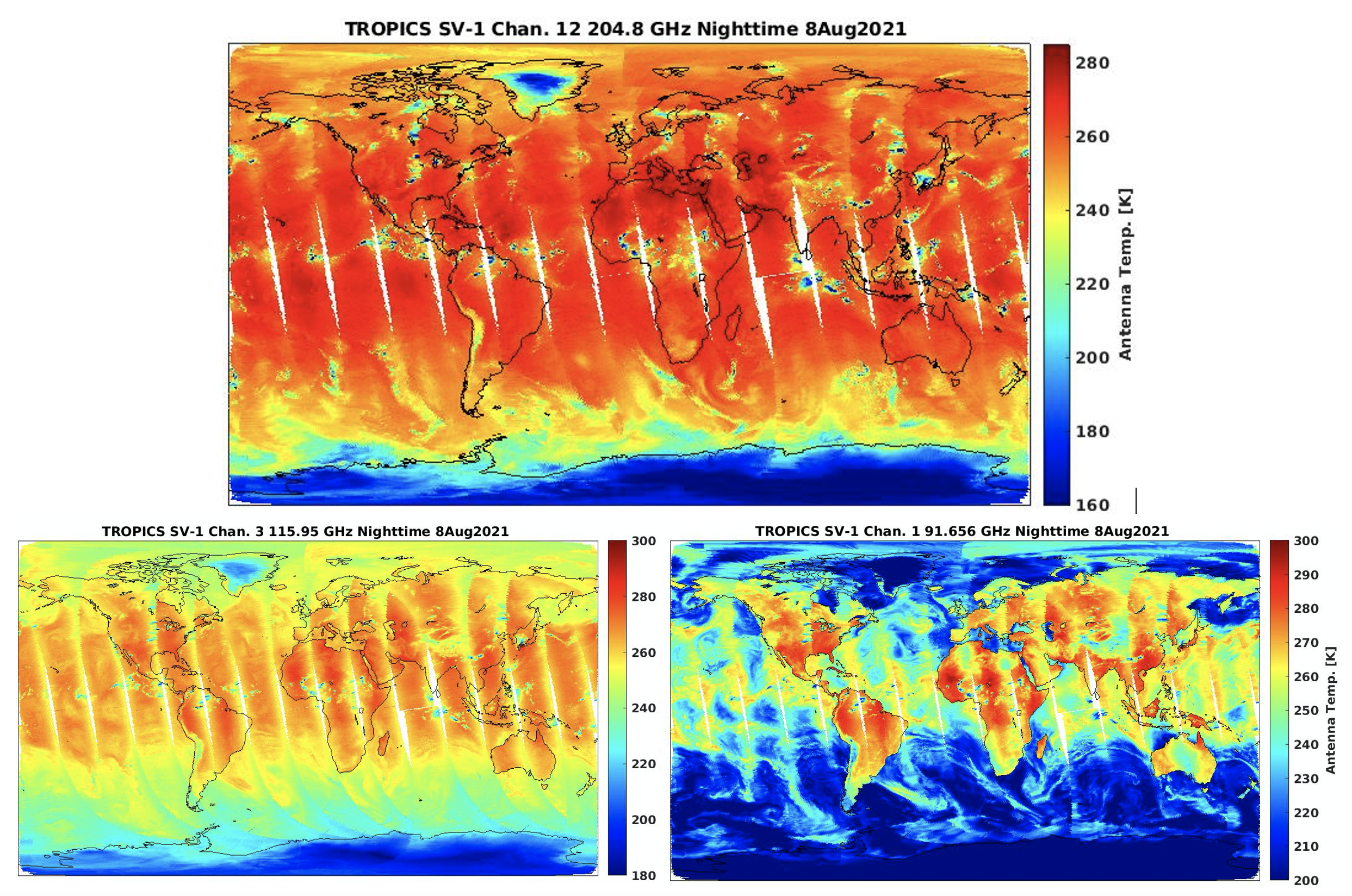
Three images produced by the TROPICS Pathfinder satellite using different frequencies.
The TROPICS Pathfinder satellite captured its first global data on August 8, 2021, including a channel around 205 GHz (top). It’s the first time a frequency higher than 190 GHz has been used on a space-borne microwave cross-track sounder instrument, which collects temperature and water vapor data using microwave radiance observations.
Credits: NASA / TROPICS Pathfinder satellite
The global first light images show microwave data collected at several frequencies, each giving scientists a different piece of the larger puzzle of thermodynamics in Earth’s atmosphere. The image, comprised of 91 GHz data, shows water vapor, including swirls of atmospheric moisture over the ocean. The data from the 115 GHz frequency provides measurements of temperature at Earth’s surface and in the lower atmosphere. The 205 GHz data yields measurements of the precipitation-sized ice particles contained within clouds. “This is the first time we’ve flown a microwave cross-track sounder using that high of a frequency,” said Blackwell. The microwave cross-track sounder is an instrument that collects temperature and water vapor data using microwave radiance observations. “It’s very sensitive to observe ice in the cloud tops, which can give us an indication of the intensity of a storm.”
TROPICS Pathfinder also captured images of Hurricane Ida on August 28 and 29, just before and after the storm made landfall in Louisiana. Read the full story about these images on the NASA Applied Sciences website.
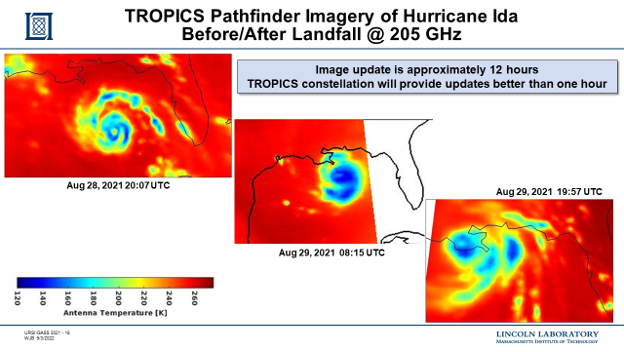
Images of Hurricane Ida before landfall (left) show a well-defined eye of the storm, as well as inner and outer rainbands that persisted as the storm made landfall in Louisiana (right).
Images of Hurricane Ida before landfall (left) show a well-defined eye of the storm, as well as inner and outer rainbands that persisted as the storm made landfall in Louisiana (right).
Credits: NASA / TROPICS Pathfinder satellite
“What the constellation will give us that we don’t have today is higher revisit rates – so we’ll be able to observe storms from space at microwave frequencies much more frequently than we can now,” said Blackwell.
By Sofie Bates
NASA’s Earth Science News Team
Link to original article NASA’s TROPICS Pathfinder Satellite Produces Global First Light Images and Captures Hurricane Ida
Storm (outflow) chasing high up in the stratosphere
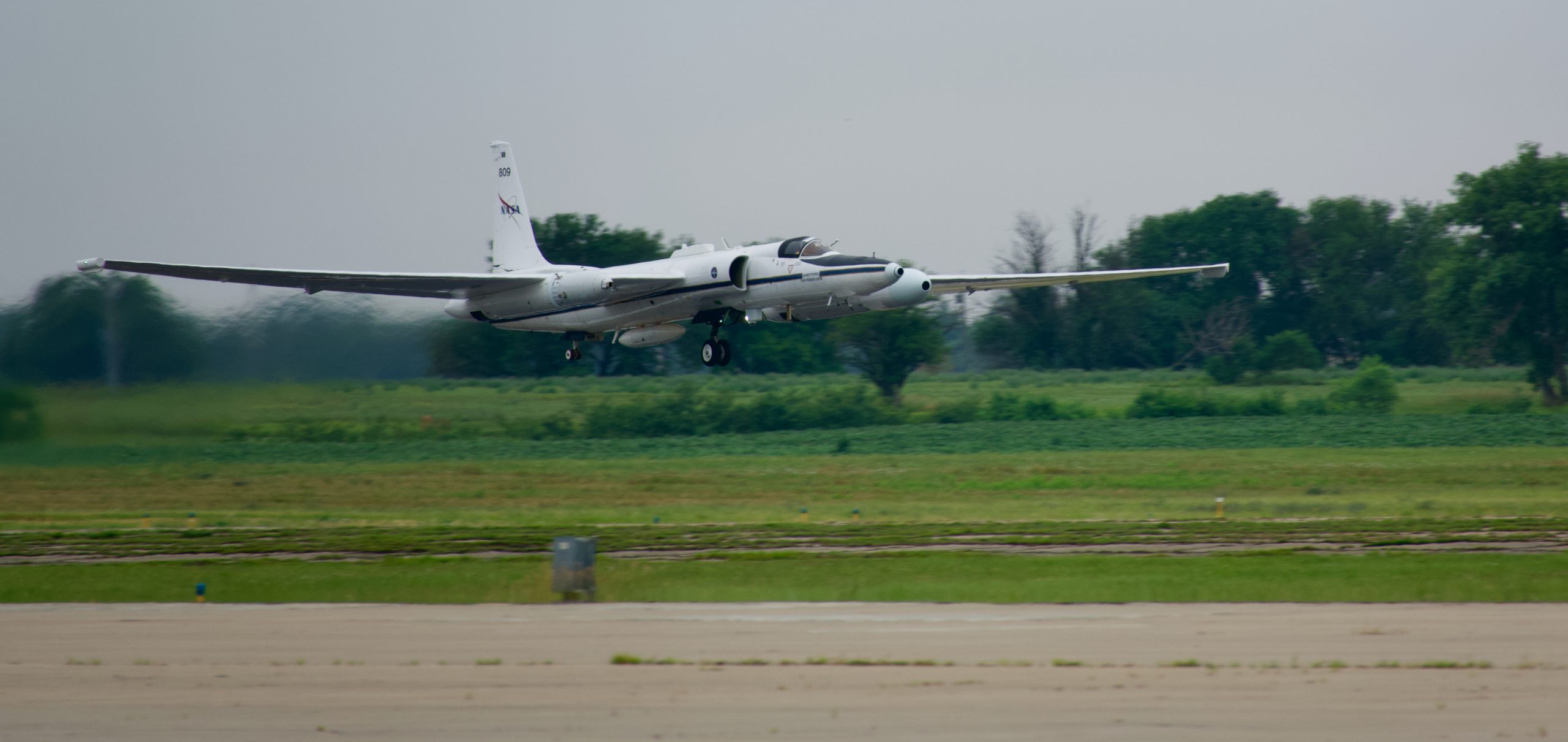 ER-2 takeoff on 16 July 2021 for DCOTSS Research Flight 01. Photo credit: Dan Chirica
ER-2 takeoff on 16 July 2021 for DCOTSS Research Flight 01. Photo credit: Dan Chirica
By Rei Ueyama, NASA Ames Research Center /SALINA, KANSAS/
It’s 3 a.m. in Salina, Kansas. The moon is out. Crickets are chirping on this balmy summer night. The light above the door to the hangar softly illuminates the sign that reads “DCOTSS.” Most teammates are just waking up. I unlock the door and walk in to be the first to start this long but exciting day full of new discoveries. It’s yet another start of a typical day of a forecaster for the NASA Dynamics and Chemistry of the Summer Stratosphere (DCOTSS) field campaign.
 A picture of the door to the hangar taken by me (Rei Ueyama) on the morning of DCOTSS Research Flight 04 on 26 July 2021.
A picture of the door to the hangar taken by me (Rei Ueyama) on the morning of DCOTSS Research Flight 04 on 26 July 2021.
About 50 of us have gathered here (and 20 more to arrive later) in the middle of the continental United States in search of strong convective storms that penetrate high into the atmosphere. These so-called overshooting storms carry water and pollutants from the boundary layer and troposphere (where we live) into the atmospheric layer above us called the stratosphere. Small turrets at the top of these strong storms overshoot into the stratosphere, and hence its name “overshoots”.
The stratosphere is a much different environment than the troposphere. For one, it is extremely dry. It also has many molecules of ozone that make up the ozone layer which protects us from harmful ultraviolet rays. Various materials pumped up from the troposphere into the stratosphere by these overshooting storms may alter the chemistry and composition of the stratosphere, which could ultimately affect Earth’s climate quite significantly. So we’re here to find out exactly how and to what extent these strong convective storms influence our climate.
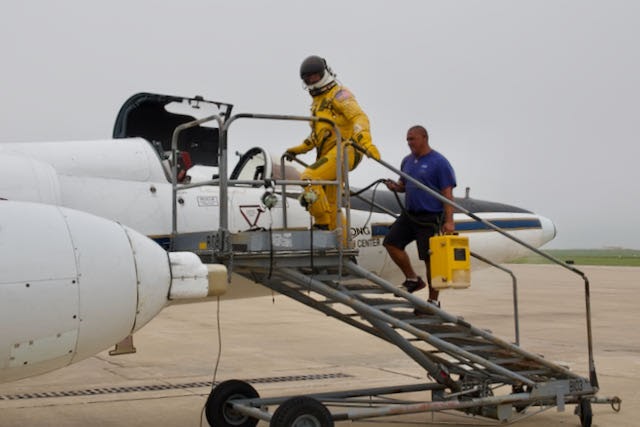 ER-2 pilot (Greg “Coach” Nelson) stepping into the aircraft for DCOTSS Research Flight 01 on 16 July 2021. Photo credit: Dan Chirica
ER-2 pilot (Greg “Coach” Nelson) stepping into the aircraft for DCOTSS Research Flight 01 on 16 July 2021. Photo credit: Dan Chirica
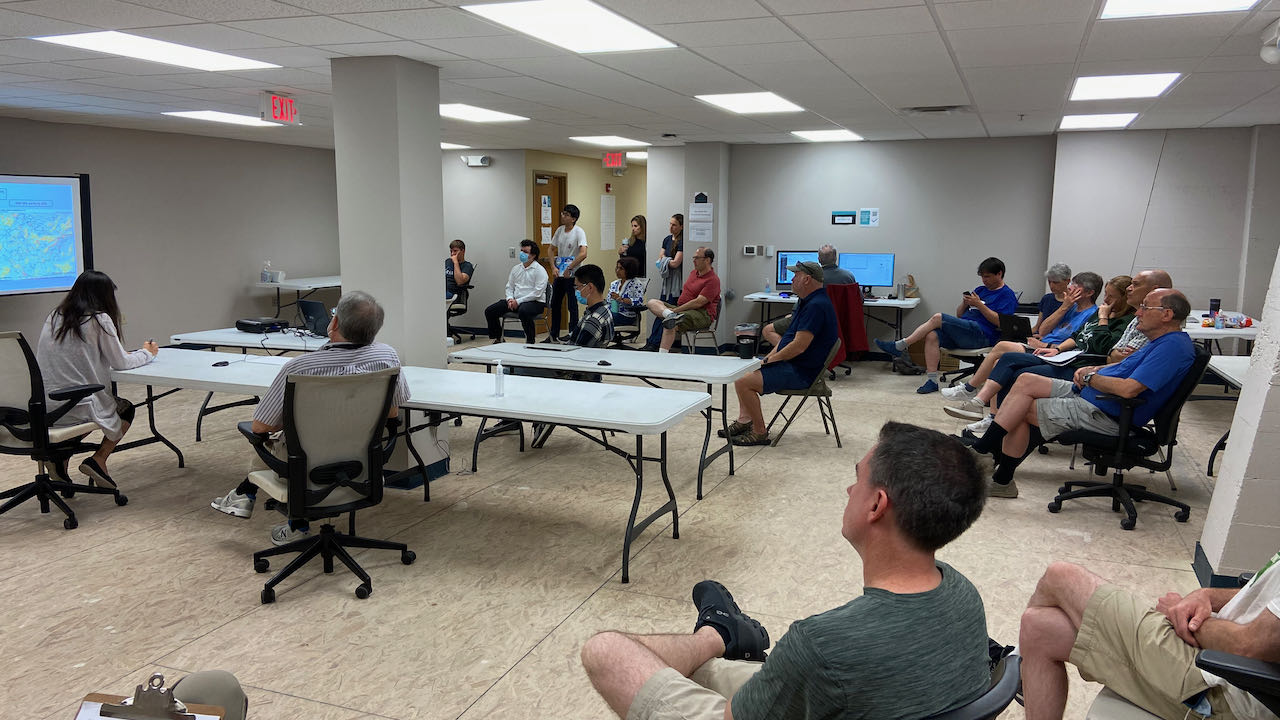 A picture of forecasting and flight planning meeting on the morning of 15 July 2021. I am sitting in the front left corner (my back facing the camera), leading the meeting. Photo credit: Dan Chirica
A picture of forecasting and flight planning meeting on the morning of 15 July 2021. I am sitting in the front left corner (my back facing the camera), leading the meeting. Photo credit: Dan Chirica
My role in DCOTSS is to lead a group of forecasters and flight planners to provide our best assessment of where the outflow plumes from overshooting storms may be located on the day of a science flight and then design a flight plan to sample those plumes. This is no easy feat as these plumes of overshooting material are often tenuous and sparse such that our effort often feels like a search for a diamond in a haystack.
As we rub our just-awoken eyes and scrutinize the early morning images of overshooting plume forecasts from satellite and radar-based models, the instrument scientists begin to arrive at the hangar to prepare their instruments for a 6 to 7 hour flight. The flight plan is tweaked, the pilot is briefed, and we are ready to go.
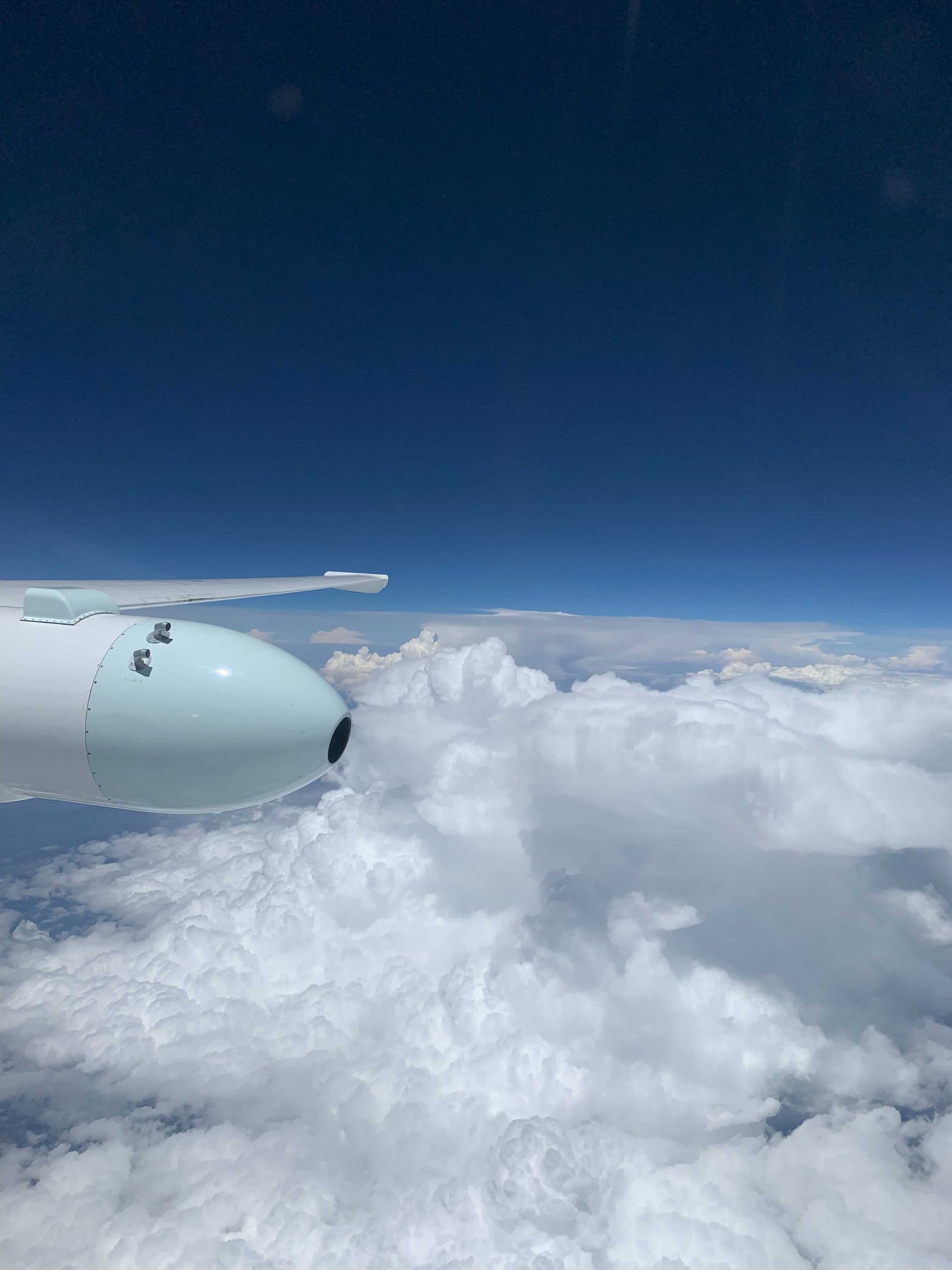 A picture of non-overshooting convective storms reaching up to 45 kft taken by the pilot (Gary “Thor” Toroni) on DCOTSS Research Flight 02 on 20 July 2021. Photo credit: Gary “Thor” Toroni
A picture of non-overshooting convective storms reaching up to 45 kft taken by the pilot (Gary “Thor” Toroni) on DCOTSS Research Flight 02 on 20 July 2021. Photo credit: Gary “Thor” Toroni
Watching the pilot navigate the ER-2 just as we had planned is very humbling and satisfying. But at the same time, our nerves are running high as the measurements from the instruments start to trickle in from the aircraft to the mission operation center on the ground. How good was our plume forecast? Do we see any indication in the measurements that the ER-2 had actually flown through a convective plume? On many occasions, it’s too early to tell. The diamond usually only shines through after the flight has been completed and after a thorough analysis of the collective measurements. Yet we are glued to our computer screens, holding our breath as we look for any signs of a convective plume in the real-time measurements.
Our job is mostly done for today, but there is no reprieve. We now look into the future to plan our next science flight. Time to hunt for another overshooting storm!
Pathfinder Satellite Paves Way for Constellation of Tropical-storm Observers
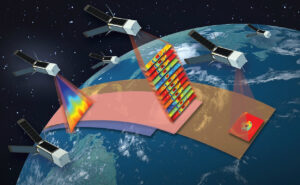
The 2020 Atlantic hurricane season was one of the most brutal on record, producing an unprecedented 30 named storms. What’s more, a record-tying 10 of those storms were characterized as rapidly intensifying — some throttling up by 100 miles per hour in under two days.
To bring more data to forecasters and have a more consistent watch over Earth’s tropical belt where these storms form, NASA has launched a test satellite, or pathfinder, ahead of a constellation of six weather satellites called TROPICS (Time-Resolved Observations of Precipitation structure and storm Intensity with a Constellation of Smallsats). Planned for launch in 2022, the TROPICS satellites will work together to provide near-hourly microwave observations of a storm’s precipitation, temperature, and humidity – a revisit time for these measurements not currently possible with other satellites.
“As a lifelong Floridian, I’ve seen firsthand the devastating impact that hurricanes can have on our communities. And as climate change is making hurricanes even stronger, it’s more important than ever that NASA and our partners invest in missions like TROPICS to better track and understand extreme weather,” said NASA Administrator Bill Nelson. “NASA’s innovation is strengthening data models that help scientists improve storm forecasting and understand the factors that feed these monster storms. TROPICS will help to do just that and we look forward to next year’s launch of the TROPICS satellite constellation.”
When launched, the TROPICS satellites will work together to provide near-hourly microwave observations of a storm’s precipitation, temperature, and humidity. The mission is expected to help scientists understand the factors driving tropical cyclone intensification and to improve forecasting models.Credits: NASA
“TROPICS is the beginning of a new era. This mission will be among the first to use a constellation of small satellites for these types of global, rapid-revisit views of tropical storms,” said Scott Braun, the TROPICS project scientist and a research meteorologist at NASA’s Goddard Space Flight Center in Greenbelt, Maryland.
Since tropical cyclones and hurricanes can change rapidly as they travel across the ocean, the increased observations from the TROPICS satellites will not only advance the science of understanding storm intensity, they also may improve intensity forecasts.
“The project holds great promise to boost NOAA’s steady improvements in weather and hurricane forecasts by feeding new environmental data into our world-class numerical weather prediction models,” said Frank Marks, director of the Hurricane Research Division of NOAA’s Atlantic Oceanographic and Meteorological Laboratory. After all six satellites are launched and positioned in 2022, “this new constellation will provide high frequency temperature and humidity soundings as we seek to learn how hurricanes interact with the surrounding temperature and moisture environment—key data that could improve hurricane intensity forecasts.”
A critical step to preparing for the constellation is the launch of a pathfinder satellite, a seventh identical copy of the TROPICS smallsats, that will enable full testing of the technology, communication systems, data processing, and data flow to application users in advance of the constellation’s launch. This will allow time for adjustments to the ground system and data products, helping ensure the success of the TROPICS mission.
“The TROPICS Pathfinder satellite is similar to a screening before the opening night of a big show,” said Nicholas Zorn, the Pathfinder program manager from MIT Lincoln Laboratory. “Its mission is a real-world, end-to-end test, from environmental verification through integration, launch, ground communications, commissioning, calibration, operations, and science data processing. Any areas for improvement identified along the way can be reinforced before the constellation launches.”
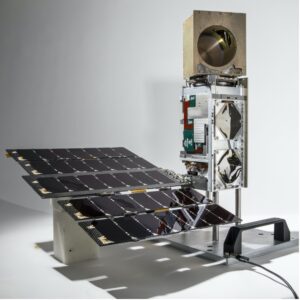
The TROPICS Pathfinder satellite, pictured above, was launched on June 30. The satellite body measures approximately 10 cm X 10 cm X 36 cm and is identical to the six additional satellites that will be launched in the constellation in 2022. The golden cube at the top is the microwave radiometer, which measures the precipitation, temperature, and humidity inside tropical storms.
Credits: Blue Canyon Technologies
MIT Lincoln Laboratory’s William Blackwell is the TROPICS principal investigator. Six years ago, he submitted TROPICS as a proposal to NASA’s Earth Venture Instrument competition series and was awarded funding. The Earth Venture Instrument program calls for innovative, science-driven, cost-effective missions to solve pressing issues related to Earth science.
Aboard each TROPICS small satellite is an instrument called a microwave radiometer, which detects temperature, moisture, and rainfall in the atmosphere. On current weather satellites, microwave radiometers are about the size of a washing machine. On TROPICS’ small satellites the radiometers are about the size of a coffee mug.
Microwave radiometers work by detecting the thermal radiation naturally emitted by oxygen and water vapor in the air. The TROPICS instrument measures these emissions via an antenna spinning at one end of the satellite. The antenna listens in at 12 microwave channels between 90 to 205 gigahertz, where the relevant emission signals are strongest. These channels capture signals at different heights throughout the lowest layer of the atmosphere, or troposphere, where most weather we experience occurs.
By flying the TROPICS radiometers at lower altitude and detecting fewer channels than their larger counterparts, in the channels they do carry, the radiometers deliver comparable performance.
Miniaturizing the microwave radiometer has been an incremental process over the last 10 years for Blackwell and his team, spurred by the invention of CubeSats, satellites the size of a loaf of bread that are often economical to launch. TROPICS builds on Blackwell and his team’s 2018 success in launching the first microwave radiometer on a CubeSat to collect atmospheric profiling data. The instrument aboard the TROPICS’ six satellites has been upgraded to provide improved sensitivity, resolution and reliability and will make more targeted and rapid weather observations.
“These storms affect a lot of people, and we expect that with the increased observations over a single storm from TROPICS, we will be able to improve forecasts, which translates to helping people get to safety sooner, protect property, and overall enhance the national economy,” Blackwell says, looking ahead to the full constellation launch next year. “It is amazing technology that we have proven out that allows us to maximize the science from the instrument’s size factor. To pull this off has taken contributions of so many people.”
The TROPICS science team includes researchers from MIT Lincoln Laboratory and MIT Department of Aeronautics and Astronautics; NASA’s Goddard Space Flight Center; NOAA Atlantic Oceanographic and Meteorological Laboratory; NOAA National Hurricane Center; NOAA National Environmental Satellite, Data, and Information Service; University of Miami; Colorado State University; Vanderbilt University; and University of Wisconsin. The University of Massachusetts Amherst, Texas A&M University and Tufts University contributed to the technology development. Maverick Space Systems provided integration services for the Pathfinder, which was launched from SpaceX’s Transporter 2 mission. Astra Space Inc. is providing launch services for the constellation. NASA’s Launch Services Program based at Kennedy Space Center procured and is managing the Tropics Pathfinder launch service.
By Kylie Foy
Massachusetts Institute of Technology, Lincoln Laboratory
NASA Media Contact: Ellen Gray, Earth Science News Team
WIRED Magazine Article -“Tiny Satellites Could Help Warn of the Next Big Hurricane”
WIRED Magazine published a fantastic article explaining the importance of TROPICS and key science and societal benefit that TROPICS and the Pathfinder will be conducting once on orbit. The following is the link to the article by Meghan Herbst

